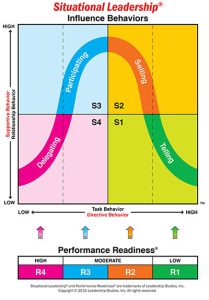Situational Leadership®
“Situational Leadership® is the most practical on-the-job tool. The application from the course to the real work environment can begin immediately.”
– Lead Organizational Development Specialist, Vidant Health
The Situational Leadership® methodology is based on the relationship between leaders and followers and provides a framework to analyze each situation based on the Performance Readiness® Level that a follower exhibits in performing a specific task, function or objective. Then, based on the leader’s diagnosis, the necessary amounts of relationship behavior and task behavior are applied and communicated to the follower in order to support their needs and advance development.

Discover the next generation of Situational Leadership® training!
Situational Leadership® Essentials
The role of the manager is becoming increasingly complex, and adaptability is the key to organizational resilience. Our new multimodal course enables leaders to overcome misalignment, build trust, increase engagement, and drive results.
Discover our flagship Situational Leadership® training!
Situational Leadership® Building Leaders
By joining this program, you’ll embark on a transformative journey toward becoming an exceptional leader. Unleash your true potential by mastering the skills to overcome misalignment, cultivate trust, ignite engagement, and unleash a wave of remarkable results.
Discover the next generation of Situational Leadership® training!
Situational Leadership® Essentials
The role of the manager is becoming increasingly complex, and adaptability is the key to organizational resilience. Our new multimodal course enables leaders to overcome misalignment, build trust, increase engagement, and drive results.
Discover our flagship Situational Leadership® training!
Situational Leadership® Building Leaders
By joining this program, you’ll embark on a transformative journey toward becoming an exceptional leader. Unleash your true potential by mastering the skills to overcome misalignment, cultivate trust, ignite engagement, and unleash a wave of remarkable results.
What is Situational Leadership®?
Situational Leadership® is a flexible framework that enables leaders to tailor their approach to the needs of their team or individual members. Developed by Paul Hersey in 1969, this model provides a repeatable process for matching leadership behaviors to the performance needs of those being influenced. Unlike other leadership models, Situational Leadership® recognizes that there is no one-size-fits-all approach, allowing leaders to adapt their behaviors to suit the unique needs of each situation.
The Four Leadership Styles of Situational Leadership®
- Style 1- Telling, Directing or Guiding: The leader makes decisions and closely supervises execution. This is a short-term approach intended to create movement.
- Style 2- Selling, Coaching or Explaining: The leader still makes decisions but provides background and context and engages with the follower to reinforce buy-in and continued progress.
- Style 3- Participating, Collaborating or Facilitating: The follower makes decisions with support from the leader in an effort to instill and enhance task mastery.
- Style 4- Delegating, Empowering or Monitoring: The follower is trusted to not only make task-related decisions but to suggest strategies for improvement and identify best practices.
The Benefits of Situational Leadership®
- Creates a common language of performance
- Accounts for multi-directional influence
- Utilizes task specificity as a measure of performance versus typecasting employees
- Allows leaders to effectively drive behavior change
- Accelerates the pace and quality of employee development
- Teaches leaders to accurately interpret and effectively respond to their environment
The Four Core Competencies of Situational Leadership®
Situational Leaders learn to demonstrate four core, common and critical leadership competencies:
- Diagnose an individual’s Performance Readiness® to complete a specific task
- Adapt leader behavior based on the diagnosis
- Communicate an influence approach in a manner that followers can both understand and accept
- Advance by managing the movement toward higher performance
